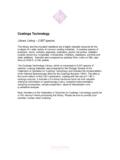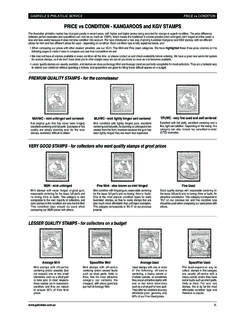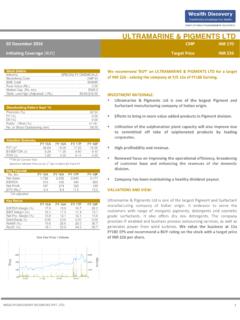Transcription of Tow Speed and Bollard Pull Analysis Project EXAMPLE ...
1 ONLINE MARINE ENGINEERING Transport Analysis Report Tow Speed and Bollard pull Analysis Project EXAMPLE Project DEMO RUN FOR REVIEW Client ORCA OFFSHORE Issue Date 18/11/2010 Report reference number: Herm-18-Nov-10-38284 Report Prepared by: Online Marine Engineering Report template revision: TRANSPORT Analysis REPORT Tow Speed and Bollard pull Analysis EXAMPLE Project Page Date : : 2 of 12 18/11/2010 ONLINE MARINE ENGINEERING TABLE OF CONTENTS GENERAL .. 4 Introduction .. 4 Scope .. 4 Bollard pull requirement .. 4 Design Velocity .. 5 Cargo characteristics .. 5 Barge Characteristic .. 5 Tug Characteristic .. 6 SUMMARY OF RESULTS AND CONCLUSIONS .. 7 Summary of Results .. 7 Conclusions .. 7 COMPUTER MODEL .. 8 General .. 8 Description of the barge model .. 9 Analysis RESULTS .. 10 General .. 10 Hydrostatic Results.
2 10 Bollard pull Analysis .. 10 Tow Speed estimate .. 11 Attachment 1: Computer Output TRANSPORT Analysis REPORT Tow Speed and Bollard pull Analysis EXAMPLE Project Page Date : : 3 of 12 18/11/2010 ONLINE MARINE ENGINEERING References 1. General Guidelines for Marine Transportation . Noble Denton International Limited, Rep No. 0030/NDI/JR Rev. 4, March 2010. 2. "Rules for planning and executing marine operations", DNV, 1999, incl. ADDENDUM 2000 3. Online Moses Reference Manual , UltraMarine TRANSPORT Analysis REPORT Tow Speed and Bollard pull Analysis EXAMPLE Project Page Date : : 4 of 12 18/11/2010 ONLINE MARINE ENGINEERING GENERAL Introduction This report presents a Bollard pull and a tow Speed Analysis on request of SPT Offshore for the EXAMPLE Project Project . The report presents the used input data and a full report of the Analysis .
3 This report has been created online without any human interference. The client should carefully check the input and output before the results can be used. It is the sole responsibility of the client to assure that the results are correct. Scope The scope of this report is to present the Bollard pull requirements and Speed estimate of this transport. The Analysis includes: Floatation Analysis 3-D Diffraction Analysis Bollard - pull calculation Tow Speed Estimate Bollard pull requirement The NDI guidelines requires that the tow should be able to maintain position for zero forward Speed against the following conditions acting simultaneously: 40 knots wind Hs = m seastate m/s current The above requirements can be found in reference 1 or 2. depending on the selected guideline for this Analysis .
4 Minimum towline pull required (TPR) will be computed based on the above conditions. The following loads will be calculated: Wind loads Using Morrison Equation with default CD Wave Drift forces Using 3-D Diffraction Current Loads Using Morrison Equation with default CD Minimum required static Bollard pull of the tug(s) will be calculated as follows: BP = TPR / Te TRANSPORT Analysis REPORT Tow Speed and Bollard pull Analysis EXAMPLE Project Page Date : : 5 of 12 18/11/2010 ONLINE MARINE ENGINEERING where Te = the tug efficiency factor. For this Analysis a Te of is used. Tow Speed estimate The target transport velocity will be 7 kn. The tow Speed for different power settings of the tugs will be calculated for Stillwater conditions and for the following environment: Seastate Hs = m, Significant wave height Tp = sec (Seastate Peak Period) Wind Vw = Knots Mean wind velocity at 10 m To represent the seastate a Jonswap spectrum with a peak shape factor of will be used without spreading.
5 Cargo characteristics The following table presents the characteristics of the cargo that has been used for this Analysis . No Name Weight LCG TCG VCG Roll Radius Pitch Radius Length Width Height - Ton m m m m m m m m 1 Accom 2 S1-S8 3 Flare Total Table Cargo characteristics Legend: LCG = Longitudinal Centre of Gravity (From Midship to aft) TCG = Transverse Centre of Gravity (From Barge centreline to Starboard) VCG = Vertical Centre of Gravity (z) (From Barge deck upwards) Roll Radius = Roll Radius of Inertia Pitch Radius = Pitch Radius of Inertia Length = Length of Cargo Width = Width of cargo Barge Characteristic TRANSPORT Analysis REPORT Tow Speed and Bollard pull Analysis EXAMPLE Project Page Date : : 6 of 12 18/11/2010 ONLINE MARINE ENGINEERING The following cargo barge have been used: Name = FPSO Model name = Barge Length = 330 m Width = 61 m Depth = 34 m Lightship = Ton with VCG at m above keel Tug Characteristic The following tugs have been used.
6 No Name Bollard pull Maximum Speed Length pp - Ton kts m 1 Tug1 2 Tug2 Total Table Tug characteristics TRANSPORT Analysis REPORT Tow Speed and Bollard pull Analysis EXAMPLE Project Page Date : : 7 of 12 18/11/2010 ONLINE MARINE ENGINEERING SUMMARY OF RESULTS AND CONCLUSIONS Summary of Results The transport with the barge FPSO for Project EXAMPLE Project has been analysed with regard to Bollard pull criteria and tow Speed . Conclusions The proposed tug arrangement does have sufficient capacity to meet the Bollard pull requirement as set by NDI.
7 The proposed tug arrangement does NOT have sufficient capacity to maintain the design Speed at calm conditions at 85% MCR power setting. The proposed tug arrangement does NOT have sufficient capacity to maintain the design Speed at the defined environmental conditions at 85% MCR power setting. TRANSPORT Analysis REPORT Tow Speed and Bollard pull Analysis EXAMPLE Project Page Date : : 8 of 12 18/11/2010 ONLINE MARINE ENGINEERING COMPUTER MODEL General This chapter presents the description of the model that has been used for the hydrostatic Analysis of the transport. For the marine Analysis , MOSES from Ultramarine, has been used. MOSES is a multipurpose marine and structural simulation computer program widely used for transport and installation design of offshore structures. See the ultramarine internet website for more information on MOSES, address is: , see reference 3.
8 The computer model used for this run has been developed by Online Marine Engineering and bears revision code The definition of the co-ordinate system for the marine Analysis is as follows: Origin at barge centre, keel level and centre line. X-axis : Positive from barge bow towards stern Y-axis : Positive towards Starboard side Z-axis : Positive is upwards See figure Figure Definition of marine co-ordinate system x y x z x y z TRANSPORT Analysis REPORT Tow Speed and Bollard pull Analysis EXAMPLE Project Page Date : : 9 of 12 18/11/2010 ONLINE MARINE ENGINEERING Description of the barge model To calculate stability a single body model is used. This model consists of one rigid body composed of several compartments with the following properties: Compartment Type Remark Barge Standard Strip theory model Barge Ballast Tanks Standard All tanks have been modelled Table Compartment properties The weights of all items have been modelled as point loads with correct inertia properties.
9 TRANSPORT Analysis REPORT Tow Speed and Bollard pull Analysis EXAMPLE Project Page Date : : 10 of 12 18/11/2010 ONLINE MARINE ENGINEERING Analysis RESULTS General The scope of the hydrostatic Analysis is to analyse the floating condition including intact and damaged stability of the transport. Hydrostatic Results The following table presents the results of the hydrostatic Analysis . Units Remarks Tow condition Intact Mean Draft m Heel Degree Trim Degree Positive is Aft down Displacement Ton Barge Displacement Table Tow condition Intact results Attachment 1 presents the detailed output of the MOSES hydrostatic Analysis . Bollard pull Analysis Minimum towline pull required (TPR) has been computed for zero forward Speed against the following conditions acting simultaneously: 40 knots wind Hs = m seastate m/s current The following loads have been calculated: Wind Drag Ton Wave drift loads Ton Current Drag Ton Total TPR Ton Minimum required static Bollard pull of the tug(s) will be calculated as follows: BP = TPR / Te where Te = the tug efficiency factor.
10 For this Analysis a Te of is used. BP = = Ton Minimum required Bollard pull The proposed tug arrangement does have sufficient capacity to meet the Bollard pull requirement. TRANSPORT Analysis REPORT Tow Speed and Bollard pull Analysis EXAMPLE Project Page Date : : 11 of 12 18/11/2010 ONLINE MARINE ENGINEERING Tow Speed estimate For the design Speed of kn, the total drag at transport draft is: Ton. Figure 6 in attachment 1 presents the towline pull against Speed curve for the tow. On this graph the expected tow Speed has been presented for different tug power settings. The following tables presents the results: Power Setting 100% 85% 70% Speed Knots Towline pull Ton Table Tow Speed Stillwater conditions The proposed tug arrangement does NOT have sufficient capacity to maintain the design Speed at calm conditions at 85% MCR power setting.








